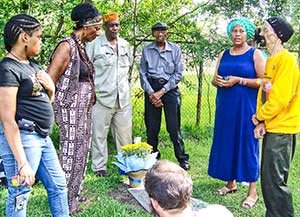
Follow workers.org on



RED HOT: TRAYVON MARTIN
CHINA,
AFGHANISTAN, FIGHTING RACISM, OCCUPY WALL STREET,
PEOPLE'S POWER, SAVE OUR POST OFFICES, WOMEN, AFRICA,
LIBYA, WISCONSIN WORKERS FIGHT BACK, SUPPORT STATE & LOCAL WORKERS,
EGYPT, NORTH AFRICA & MIDDLE EAST,
STOP FBI REPRESSION, RESIST ARIZONA RACISM, NO TO FRACKING, DEFEND PUBLIC EDUCATION, ANTI-WAR,
HEALTH CARE,
CUBA, CLIMATE CHANGE,
JOBS JOBS JOBS,
STOP FORECLOSURES, IRAN,
IRAQ, CAPITALIST CRISIS,
IMMIGRANTS, LGBT, POLITICAL PRISONERS,
KOREA,
HONDURAS, HAITI,
SOCIALISM,
GAZA



|
|
HOUSTON
Activists honor Panther leader Carl Hampton
By
Gloria Rubac
Houston
Published Aug 2, 2008 7:38 AM
Black Panther leader Carl Hampton was remembered and honored as a true leader
of the people on the 38th anniversary of his assassination by the Houston
police on July 26, 1970.
|
Paying respects at Carl Hampton’s
gravesite, July 26.
WW photo: Gloria Rubac
|
Carl Hampton wanted to begin a chapter of the Panthers in Houston in 1969 when
he returned there after working with the Black Panther Party in Oakland, Calif.
But the party was not authorizing new chapters at the time. Recognizing that
the BPP was the first party of the people, he decided to form Peoples Party II
in Houston.
His former comrades along with Houston activists of all ages gathered in
Houston’s Third Ward on the vacant lot on Dowling Street where the
Panther headquarters once stood. A large table held copies of old newspaper
articles, posters of Hampton, photos of many of the Black Panther Party
leaders, photocopies of Black Panther newspapers, and T-shirts with
Hampton’s photo on the front and a quote by James Aaron on the back.
In near 100-degree weather the crowd then caravanned to the cemetery where
Hampton is buried. People took turns remembering him and talking about his
life.
Speakers included former Panther Aaron, who took leadership of the organization
after Hampton’s murder; former Panther Ayanna Ada; and Green Party
activist Alan Purium.
Former Panther Sensei Benton read a short biography of Hampton written by
Brother Boko Freeman, who had been the Minister of Culture and a leader of the
Houston Chapter, who now lives in Atlanta. “On July 26, 1970, Carl
Bernard Hampton, one of Black America’s most articulate, courageous and
heroic young leaders was ruthlessly slain by the Houston Police
Department’s Criminal Intelligence Division. At the age of 21, Carl was a
tireless organizer who worked day and night. ... Armed with determination to
see his people free from the oppression, exploitation and degradation by a
racist and corrupt system bent on the destruction of Blacks and people of color
... he rallied people around the issue of police brutality and murder. ...
Speaking with much power and authority, he was able to capture the hearts and
minds of the people and therefore their respect and admiration.”
Benton also read an anonymous letter written to Hampton after his death. It was
from a young man who wandered into the Panther headquarters while looking for a
job. He said Hampton talked with him for a good while and bought him a soda
even though he couldn’t afford it.
The letter concluded: “Maybe you had to die for what you stood for. You
were an intelligent young man and devoted to your people. So I shall close,
Carl, and hope you didn’t die for no reason. I shall close with my
tear-stained eyes, for I loved you so. Good night, Carl Hampton, although I
just met you one time, good night. Your 30-minute friend and
brother—although you didn’t know my name, but you knew my face.
Goodbye.”
After flowers were left on the grave, the activists returned to Third Ward.
Then two long-time activists, Ester King and Ovide Duncantell, who were both on
Dowling Street on the night of the murder, told what they had seen and what the
police had done 38 years earlier.
They took the crowd to the exact spot where Hampton had been shot and told how
the cops had been allowed to use a three-story church as the base of their
military operation. “The minister of Saint John’s had cancelled the
Sunday evening services and allowed the cops to take over the church. While
there were cops and news media on the roof of the church, Carl was shot from
the second story where you now see the stained glass windows,” said
King.
“Carl was shot standing right here next to this pole,” described
Duncantell. “After they shot Carl with illegal, hollow-point, dum-dum
bullets, he lay in the street bleeding profusely. The Panthers and the
community responded to the cops, using arms of their own. Many people were shot
that night, including Johnny Coward, who had the heel of his foot shot off, and
Bartee Haile, a white leader of the John Brown Revolutionary League. Both were
later charged with attempted murder of a police officer. About 60 people were
arrested, including Mickey Leland, who was later elected to the U.S. House of
Representatives. A woman who drove down the street dodging a hail of bullets
somehow picked up Carl’s body and took him to the hospital. ”
Benton added, “All we know about this woman is that her name was Sophia.
We would like to find her.”
A legacy of heroism
After leaving the scene of Hampton’s murder, the crowd reassembled down
the street at the Project Row House Park to further remember Hampton. As
Peoples Party III leader Kenyha Shabazz was speaking on a loud sound system, a
woman entered the park and said she was passing by and heard the name of Carl
Hampton. She wondered what was happening.
When told that Hampton was being honored, she proceeded to tell the crowd that
she had known Hampton and how much he was loved by the community. When asked
her name, she responded, “Sophia.”
She was the woman who had picked up Hampton’s bleeding body and tried to
help save his life. The crowd became electrified, since just minutes before
they were discussing trying to find this woman and honor her for her heroism
that night in 1970. The former Panthers asked her to describe what she did when
Hampton was shot.
“I put him into my pickup truck and took all his Panther identification
off him and admitted him to the hospital in my husband’s name so they
would treat him. But Carl was in and out of consciousness, and I am not sure he
was even alive when I got him to the hospital. I loved him so much,” she
said while crying. “I can’t believe they murdered him. He was so
important, he loved all people, and I have never forgotten him,” she said
to a stunned crowd.
Capturing the essence of the day, Benton told Workers World, “The legacy
of Carl Hampton is seriously important because so much history has been buried.
Carl is the focal point, the epicenter of our past struggles, and it is vitally
important that this history be exposed. There need to be some heroes and
heroines in the Black community, people that the community can look up to. Carl
is a shining example of positive work and inspires us still.
“The cops murdered Carl without any repercussion or
investigations,” he continued. “This needs to be brought out. We
don’t need a monument or a symbol but some serious work in the community.
As we were gathering tonight, a man was in the dumpster looking for a meal.
Across the street from where Carl was shot, I saw that people are camping and
living in the empty lot. The brother gave his life so that all could have a
place to stay and clothes on their backs and good food to eat. The very issues
that Carl struggled around and gave his life for still need addressing. This is
a human struggle, and Carl is a legacy of that struggle. We want to keep this
struggle alive.”
“The thing that dragged me into the Party was members’ dedication
to the people,” explained former member Bobby Reed. “Their love
just grabbed me. They would go without in order to serve the people, and I had
to be a part of that.”
Former Panther Ayanna Ada suggested that “funds be raised to buy a
headstone for Carl’s grave and that by his birthday in December or at
least by next summer on July 26, we gather around that headstone to again
remember Carl.”
Former Panthers and The Station Museum, which is hosting an exhibit of Black
Panther Party art, including photos, newspapers and historic posters, organized
the memorial for Carl Hampton. The following day the museum held a film showing
of “The Murder of Fred Hampton.”
Articles copyright 1995-2012 Workers World.
Verbatim copying and distribution of this entire article is permitted in any medium without royalty provided this notice is preserved.
Workers World, 55 W. 17 St., NY, NY 10011
Email: [email protected]
Subscribe [email protected]
Support independent news DONATE
|
|


